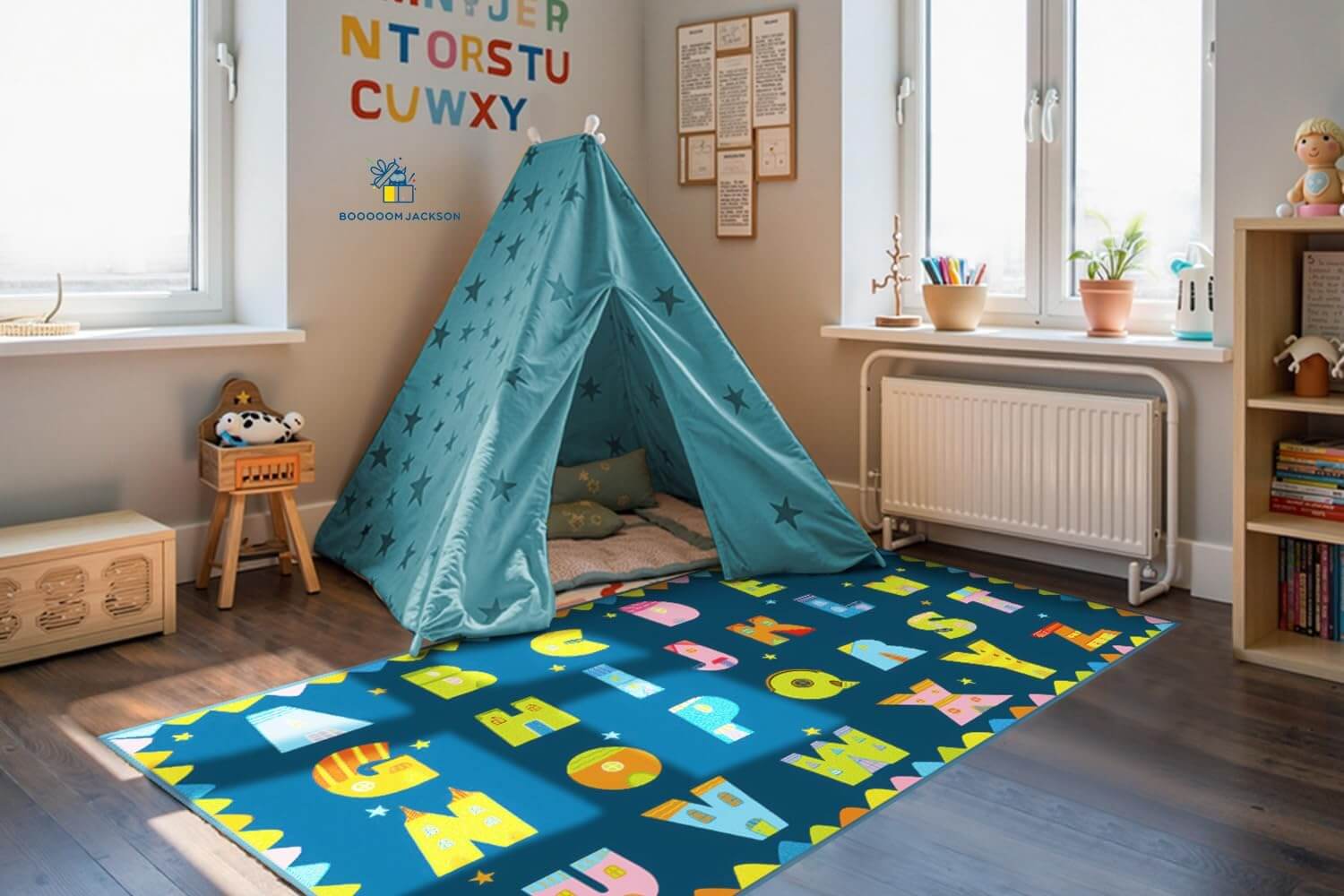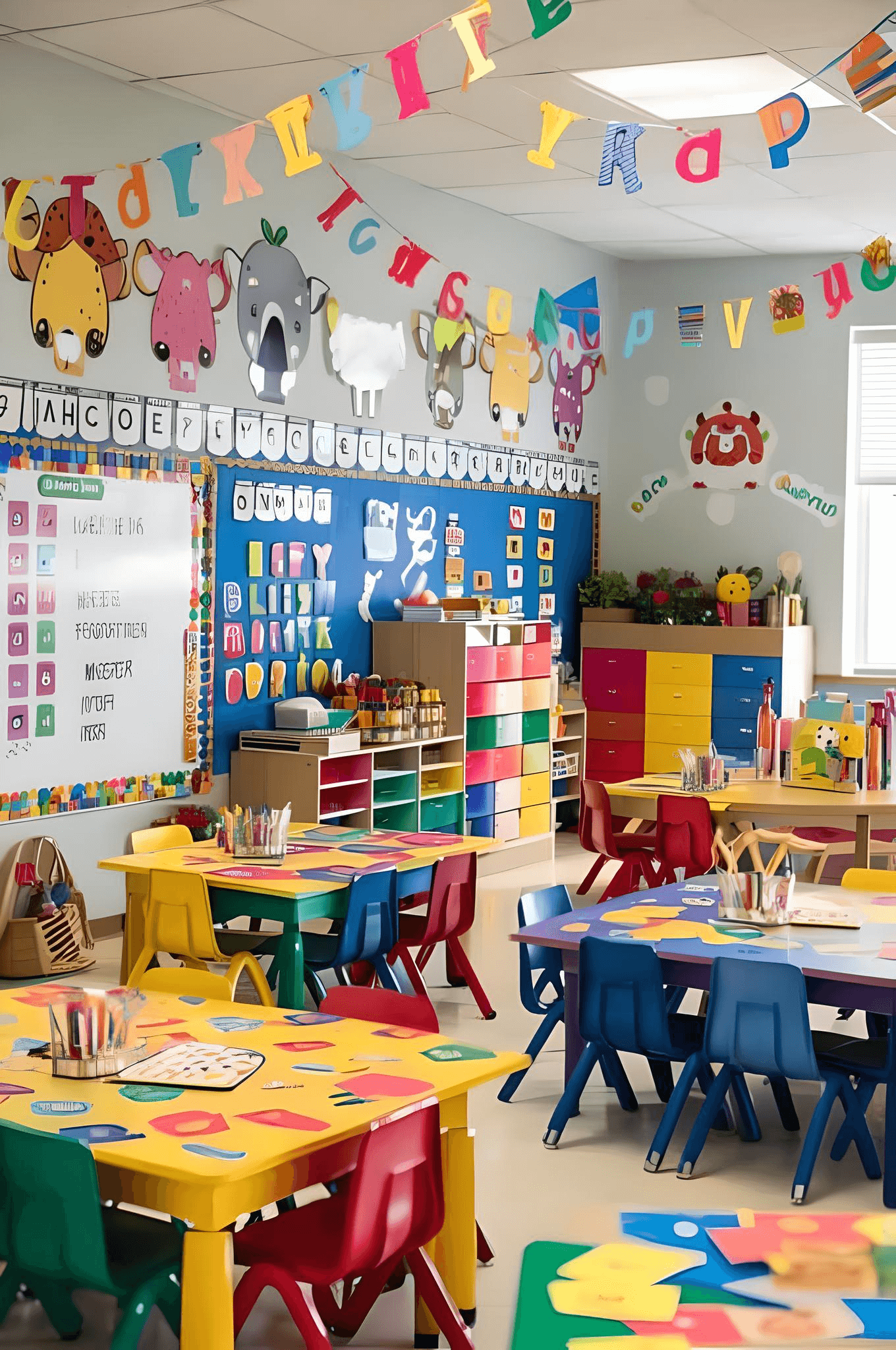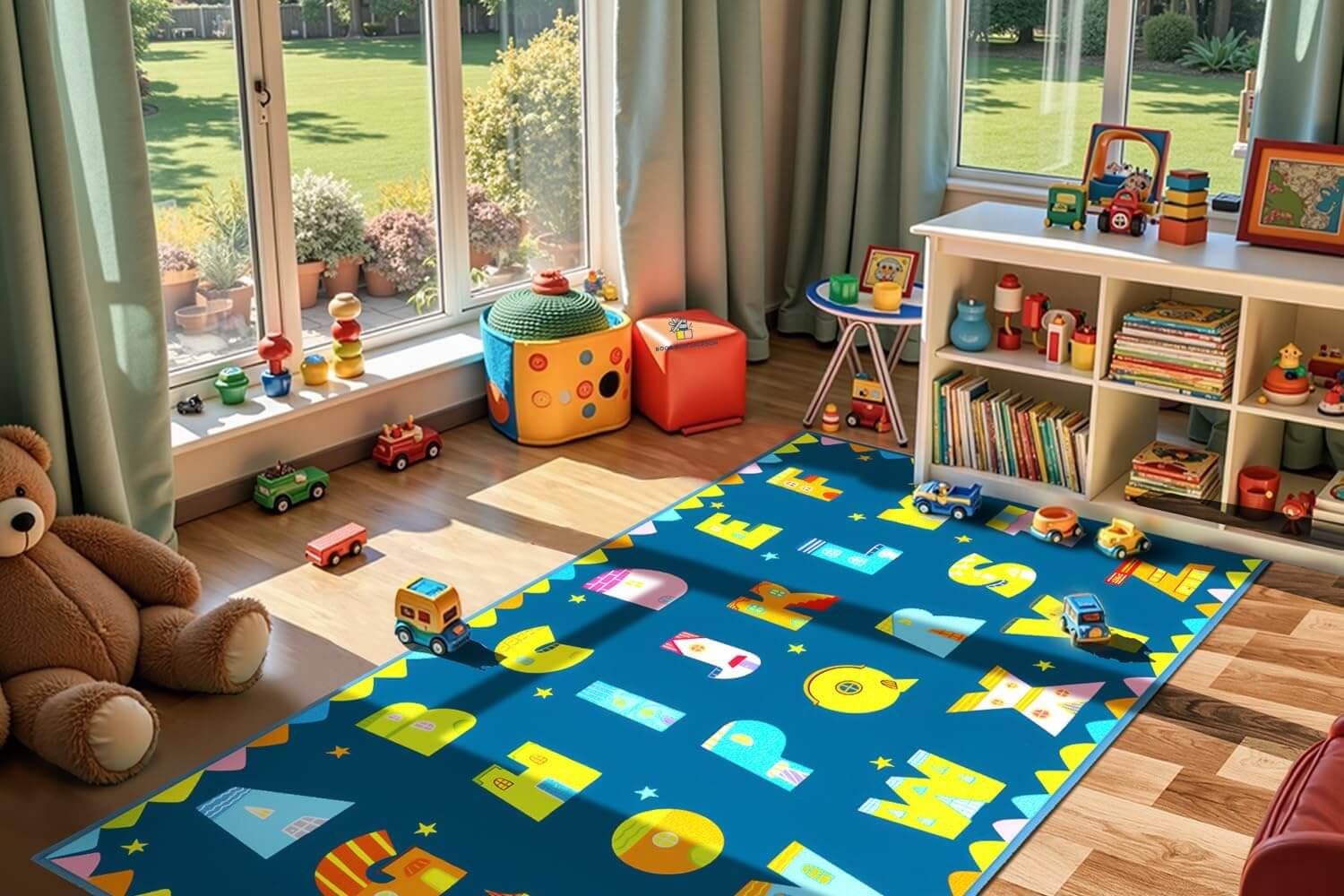Remember those alphabet border classroom rugs from your elementary school days? The ones with primary colors so bright they practically glowed? Well, honey, classroom carpets have come a loooong way since then! Today's educational floor coverings are equal parts stunning design statements and powerful learning tools.
At BooooomJackson, we've had a front-row seat to the fascinating evolution of classroom carpet styles. Let's take a walk through the design decades to see how these humble floor coverings have transformed from simple sitting spots to sophisticated learning environments!
The Carpet Time Machine: A Style Evolution
1950s-60s: The Practical Pioneers
Back when classroom design was all about function over form, classroom rugs were decidedly...well, boring. Think:
- Solid colors (usually that unmistakable "institutional green")
- Virtually indestructible industrial materials
- Zero educational elements
- Simple rectangular shapes
As educational environment historians note, this era prioritized durability and uniformity, reflecting the overall educational approach of the time.
"My first classroom in 1968 had a plain brown rectangle that was solely for 'story time,'" recalls retired teacher Ms. Rodriguez. "That carpet's only job was keeping little bottoms off cold linoleum floors. The idea that the carpet itself could be a teaching tool? Completely foreign concept back then!"
1970s-80s: The ABC Revolution
The 1970s brought the first major innovation in classroom carpet design—the now-iconic alphabet border!
- Primary color schemes (hello, fire-engine red and royal blue!)
- Basic educational elements (ABCs, 123s)
- Simple geometric shapes at the center
- Improved but still industrial-feeling materials
This era marked the first recognition that carpets could reinforce basic educational concepts, though the design approach remained fairly utilitarian.
"Everyone my age remembers those bright alphabet rugs," laughs veteran teacher Mr. Washington. "They were revolutionary at the time—suddenly circle time included spontaneous letter recognition games. Though looking back, they were still pretty basic compared to what we have now."
According to educational design researchers, this period represented the first acknowledgment that physical classroom elements could actively contribute to learning.
1990s-2000s: The Interactive Era
The 1990s saw the carpet transform from passive to active learning tool:
- Colorful game boards woven right into designs
- Map and globe patterns for geography learning
- Calendar and weather tracking features
- Assigned seating spots (those little circles or squares)
"When I got my first interactive carpet in 1995, it completely changed my teaching approach," shares kindergarten teacher Ms. Chen. "Suddenly carpet time wasn't just for listening—it was for doing! We played addition games, mapped states, and tracked the weather all on our classroom rug."
This shift aligned with broader educational trends toward more hands-on, constructivist learning approaches gaining popularity during this period.
2010s-Present: The Design Revolution
Today's classroom carpets reflect sophisticated understanding of both design aesthetics and learning psychology:
- Subtle color palettes informed by color psychology research
- Nature-inspired elements supporting biophilic design principles
- Multiple educational layers creating cross-curricular opportunities
- Diverse cultural influences celebrating global perspectives
- Specialized zones supporting different learning modalities
"Our BooooomJackson Contemporary Learning Carpet looks more like something from a high-end design magazine than traditional 'school furniture,'" notes third-grade teacher Mr. Patel. "The muted blues and greens create this calm, focused energy while the subtle geometric patterns support mathematical thinking without overwhelming the senses."
This evolution mirrors what classroom environment specialists identify as a fundamental shift toward recognizing the physical space as an active "third teacher" in the learning process.
Modern vs. Traditional: How Carpet Styles Impact Learning
Beyond the fascinating historical journey, there's an interesting question about how different carpet styles affect the learning atmosphere. Let's explore the distinct impact of various design approaches:
Traditional Style Impact
Classic educational carpet designs featuring:
- Bright primary colors
- Explicit educational elements (alphabets, numbers, maps)
- Clear delineations and borders
- Structured learning zones
Learning Impact:
- Clarity and Structure: Traditional designs provide clear visual instructions
- Easy Recognition: Explicit educational elements support direct instruction
- Familiar Comfort: The recognizable style creates security for students
- Teacher-Directed Learning: Designs naturally support teacher-led activities
As Ms. Jackson, a veteran kindergarten teacher explains: "For my students with attention challenges or those who benefit from very explicit structure, our BooooomJackson Classic Learning Carpet provides visual boundaries and clear learning cues that help them navigate the school day."
According to educational psychologists, these explicit visual supports particularly benefit students with attention differences or those who thrive with clear structure.
Contemporary Style Impact
Modern educational carpet designs featuring:
- Subtle, nature-inspired color palettes
- Implicit rather than explicit learning elements
- Flowing, organic patterns and shapes
- Multi-interpretive design elements
Learning Impact:
- Calming Atmosphere: Softer colors reduce visual overstimulation
- Imagination Activation: Open-ended designs encourage creative thinking
- Flexible Interpretation: Patterns can support multiple learning concepts
- Student-Directed Exploration: Designs naturally facilitate discovery learning
"Since switching to our BooooomJackson Modern Minimalist Carpet, I've noticed a significant shift in how students engage during carpet time," shares second-grade teacher Ms. Thompson. "The conversations are more creative, the energy is calmer, and students seem more comfortable sharing ideas because the space feels less 'schooly' and more like a thoughtful community gathering place."
This aligns with research on classroom aesthetics, which suggests that visually calmer environments may support deeper cognitive processing and creative thinking.
Transitional Style Impact
Blended educational carpet designs featuring:
- Balanced color schemes (neither too bright nor too muted)
- Mix of explicit and implicit learning elements
- Combination of structured and open-ended zones
- Traditional elements with contemporary execution
Learning Impact:
- Style Versatility: Works with varied teaching approaches
- Broad Appeal: Meets diverse student preferences and needs
- Instructional Flexibility: Supports both direct teaching and exploration
- Visual Harmony: Creates balanced sensory environment
"Our BooooomJackson Transitional Learning Carpet has been the perfect middle ground for our diverse student population," explains fifth-grade teacher Mr. Washington. "The calendar and math elements provide structure for my students who need that explicit support, while the flowing river design and abstract patterns engage my more creative thinkers."
This balanced approach reflects current universal design for learning principles, which emphasize creating learning environments that offer multiple access points for diverse learners.
Finding Your Perfect Classroom Carpet Style
With so many design approaches available, how do you choose what's right for your classroom? Consider these key factors:
1. Know Your Teaching Style
Your carpet should complement your instructional approach:
- Direct instruction focus: Consider more traditional designs
- Inquiry-based learning: Explore contemporary patterns
- Varied methodologies: Look at transitional styles
"I'm a pretty structured teacher with predictable routines, so I thought I'd prefer a traditional carpet design," shares first-grade teacher Ms. Rodriguez. "But actually, I found that a more contemporary BooooomJackson design created a nice balance in our classroom—bringing in some organic elements to soften my natural tendency toward structure."
2. Consider Your Student Population
Different student groups may respond better to certain styles:
- Younger students: Often benefit from more explicit design elements
- Students with attention challenges: May thrive with clearer boundaries
- Creative learners: Often engage more deeply with contemporary designs
- Diverse classrooms: Usually respond well to transitional approaches
As special education teacher Mr. Chen advises: "Really observe how your specific students respond to different visual environments. The trends are helpful starting points, but your particular students' needs should drive the final decision."
3. Harmonize With Your Space
Your carpet should complement your overall classroom design:
- Consider wall colors and existing furnishings
- Think about natural light levels in your space
- Evaluate the size and shape of your classroom
- Reflect on the overall sensory environment
Classroom design experts emphasize the importance of creating a cohesive visual environment rather than treating elements in isolation.
4. Balance Trendiness With Timelessness
While it's fun to embrace current design trends, remember that quality carpets are long-term investments:
- Opt for styles with staying power
- Consider designs that can evolve with different lessons
- Look for patterns that won't quickly feel dated
- Balance trendiness in smaller, more replaceable classroom elements
"I fell in love with a super-trendy neon geometric carpet pattern that was all the rage last year," admits third-grade teacher Ms. Patel. "Looking back, I'm so glad our principal guided me toward the more timeless BooooomJackson design that still feels fresh and relevant this year."
Style Evolution in Action: Teacher Success Stories
Teachers nationwide are discovering how different carpet styles transform their classroom dynamics:
"After 15 years with a traditional alphabet carpet, I switched to a contemporary design with subtle nature elements," shares veteran kindergarten teacher Ms. Taylor. "I was worried my students would miss the explicit learning cues, but instead, I've been amazed by how the new carpet has sparked more imaginative discussions and calmer transitions. The children seem more inclined to gather on the new carpet even during free choice time!"
"Our grade level team experimented with different carpet styles in our four classrooms," explains second-grade team lead Mr. Washington. "We've found that while all styles have their strengths, the transitional designs from BooooomJackson seem to offer the greatest versatility across our diverse teaching styles and student needs. They provide enough structure for clarity while still offering creative openness."
"As a special education teacher supporting students in different classrooms, I've had the unique opportunity to observe how carpet styles affect various learners," notes Ms. Jackson. "What's fascinated me is that while conventional wisdom might suggest students with learning differences need very structured, traditional designs, many of my students actually respond more positively to contemporary styles with their calmer colors and less visually busy patterns."
The Carpet Style Forecast: Where Design Is Heading
As we look toward future classroom carpet trends, several exciting directions are emerging:
Biophilic Dominance
Nature-inspired designs are moving from trend to standard practice as research on biophilic design benefits continues to demonstrate significant positive impacts on learning outcomes. Expect to see more:
- Subtle nature representations
- Organic patterns and shapes
- Natural color palettes
- Environmental elements
Cultural Inclusivity
Carpet designs are increasingly reflecting diverse cultural aesthetics:
- Global pattern influences
- Multicultural celebrations
- Indigenous design elements
- Worldwide natural wonders
Sensory Consideration
As understanding of sensory processing grows, carpet designs are evolving to support sensory needs:
- Reduced visual busyness
- Strategic use of color psychology
- Intentional pattern placement
- Multi-sensory engagement opportunities
Technological Integration
The most innovative new designs are incorporating:
- QR codes woven into patterns
- Augmented reality compatibilities
- Interactive elements that connect to apps
- Digital learning extensions
The Bottom Line: Style With Substance
The evolution from basic classroom rugs to sophisticated design elements reflects a deeper understanding of how profoundly physical environments affect learning. Today's diverse carpet styles aren't just about aesthetics—they're about creating spaces that enhance education through intentional design.
As Ms. Rodriguez beautifully summarizes: "When I started teaching 25 years ago, no one would have believed that something as simple as carpet design could impact learning outcomes. Now I understand that every element in my classroom—from the carpet up—either supports or hinders my students' educational experience. Choosing the right style isn't about following trends; it's about creating the optimal environment for my unique classroom community."
Whether you lean toward traditional classroom charm, contemporary sophistication, or something in between, today's educational carpet options offer design choices that enhance learning while reflecting your personal teaching style. Because at the end of the day, the best classroom carpet isn't just about how it looks—it's about how it helps your students learn, grow, and thrive.




Leave a comment
This site is protected by hCaptcha and the hCaptcha Privacy Policy and Terms of Service apply.